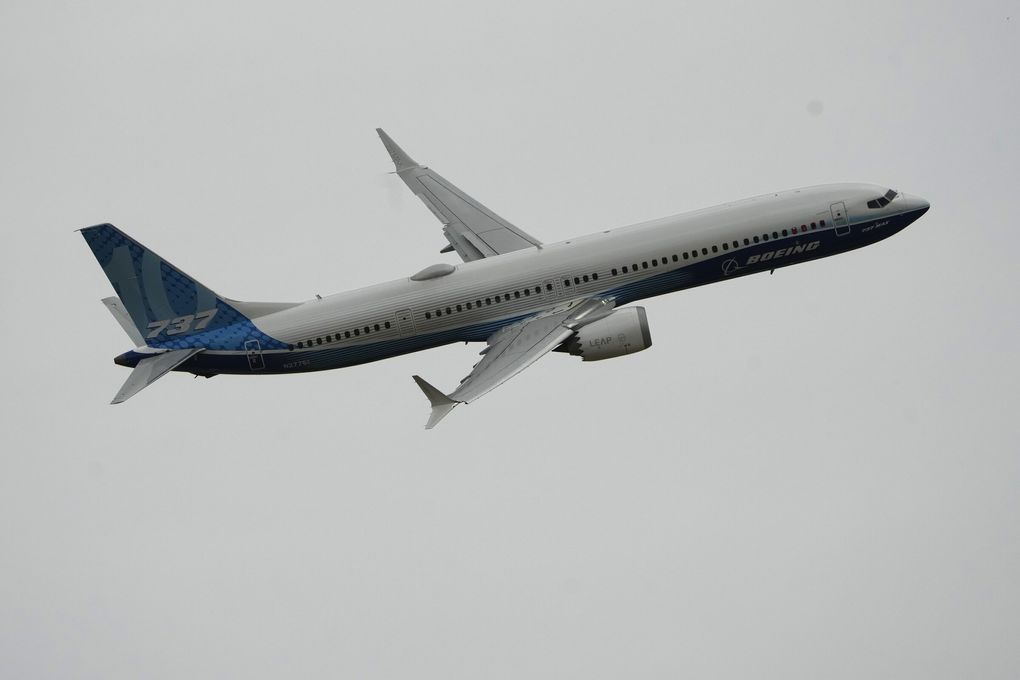Boeing & Aerospace Business Nation & World
Boeing reveals 737 MAX sales breakdown for the first time
Aug. 8, 2023 at 8:00 am Updated Aug. 8, 2023 at 8:00 am

The breakdown of Boeing’s orders shows the substantial sales success of the largest MAX, the MAX 10, designed for up to 230 seats. (Lewis Joly / AP)

By
Dominic Gates
Seattle Times aerospace reporter
Boeing on Tuesday revealed for the first time the breakdown of its 4,339 gross unfilled 737 MAX orders by model.
The breakdown shows the substantial sales success of the largest MAX, the MAX 10, designed for up to 230 seats. That jet won’t be certified by the FAA to enter service until next year yet has already booked just over 800 unfilled orders as of the end of July.
That makes clear how critical it is for Boeing to get that jet certified as soon as possible.
Boeing won’t officially give a timeline for that so as not to seem to put pressure on the Federal Aviation Administration. However in June a person working the MAX 10 certification for Boeing said that internally it projects entry into service by the middle of next year.
The initial MAX model, the MAX 8 — which American Airlines, for example, configures with 172 seats — remains at the center of the MAX order book with almost 1,000 already delivered and more than 2,700 unfilled orders.
Boeing has also delivered 124 of the high-density 200-seat version of that model, the MAX 8-200 designed for Ryanair, with another 344 unfilled orders.
The MAX 9, with 187 already delivered, has 137 unfilled orders.
The smallest model, the MAX 7, also not yet certified, has 297 unfilled orders; nearly two-thirds of those will go to Southwest.
Boeing’s official MAX backlog stands at 3,839 aircraft. That’s less than the gross total above because it omits orders for 500 jets that have become doubtful since the contracts were signed and can no longer be relied upon.
That number must include the 118 unfilled MAX orders listed in the Boeing database as earmarked for Chinese airlines. Until there is some formal political rapprochement between the U.S. and China those have to be classified as uncertain.
Boeing lags now but Airbus faces trouble
The data released Tuesday also shows that Boeing delivered 43 jets and finalized 52 net new orders in July.
Boeing’s rival Airbus remains well ahead in orders and deliveries. However, a problem with Airbus engines disclosed at the end of July may give Boeing a chance to make up some lost ground in the coming months.
Boeing’s July deliveries included 32 single-aisle 737 MAXs, four widebody 787 Dreamliners and six widebody freighter jets.
United Airlines took delivery of nine MAXs in the month while Southwest took seven and Ryanair four.
Some of the MAXs were planes delivered from the inventory of aircraft that have been parked since the 737 was grounded in 2019. Boeing didn’t disclose how many deliveries were from that store of airplanes versus newly built planes.
The July orders included one for 39 widebody 787 Dreamliners from Saudi Arabian Airlines that was announced in February and finalized only last month.
In addition to the new orders, Boeing in July restored a total of 40 jet orders to its official backlog. Those orders were previously considered uncertain, but with demand for airplanes soaring worldwide those contracts have now been solidified.
July’s outcome brings Boeing’s 2023 delivery tally to 309 commercial airplanes, and its total new net orders through July to 467.
Airbus delivered 65 jets in July and booked 57 net orders, according to data the European aircraft manufacturer released last week.
The gross order total of 60 was cut when three widebody A350-900s were canceled.
Through July, Airbus delivered 381 jets and amassed 1,101 net orders.
The big Airbus sales lead for the year comes largely from a single order made at the Paris Air Show in June, when Indian low-cost carrier Indigo ordered 500 single-aisle A320 jet family aircraft.
The Airbus airplane delivery advantage comes from higher production of its A320 family of jets compared to the Boeing 737 MAX.
However, at the end of July, Airbus engine supplier Raytheon disclosed a quality problem affecting Pratt & Whitney Geared Turbo Fan (GTF) engines already in service on A320s and A220s.
Although new GTF engines are not affected, this could slow the supply of new engines to Airbus as Pratt scrambles to provide spare engines to airlines with grounded planes.
The precise impact is not yet clear. Many A320s are delivered not with Pratt’s GTF engines but with LEAP engines from CFM, which don’t have the problem.
Both Airbus and Boeing have struggled this year with post-pandemic supply chain shortages slowing production. In addition, Boeing has had to handle a series of manufacturing defects interrupting deliveries.
This time, it’s Airbus facing that problem. Boeing is unaffected as it doesn’t use the Pratt engine; the 737 MAX is powered exclusively by the LEAP.
The A320neo family gross backlog is just over 6,700 aircraft. Unlike Boeing, Airbus doesn’t make public the net backlog after cutting orders not considered solid.
In a notable change to the Airbus backlog in July, low-cost U.S. carrier Spirit converted its remaining 31 orders for the small A319neo to the largest model A321neo, while at the same time pushing out some deliveries.
The A321neo has been a hot seller for Airbus, landing nearly 5,300 orders. In July, almost half its deliveries were of this model.
In contrast, the A319neo has booked only 61 total orders, of which just 47 are left to deliver.
Sales of the A319neo may have been impacted by the debut of the small single-aisle A220 jet family that Airbus purchased from Bombardier; it’s now ramping up A220 production.
The lack of A319neo sales means the main Airbus single-aisle jet family now consists of essentially just two models, the A320neo and the A321neo.
Boeing’s rival 737 MAX jet family, though lagging in total orders, does have a broader range.
It offers the MAX 8 and MAX 10 head-to-head against the two key Airbus models, while the MAX 7 and MAX 9 add options attractive to some airlines.
Boeing hopes that once the MAX 10 and MAX 7 are finally cleared to enter service, sales will pick up even more.
Dominic Gates: 206-464-2963 or dgates@seattletimes.com; on Twitter: @dominicgates.
seattletimes.com |






